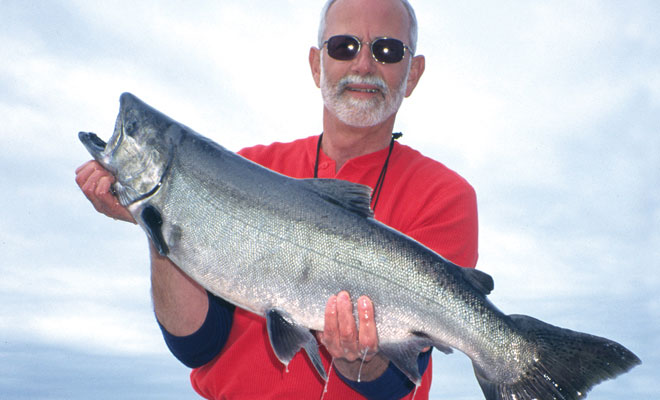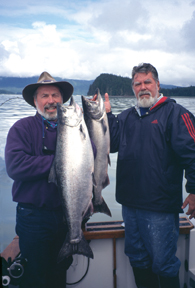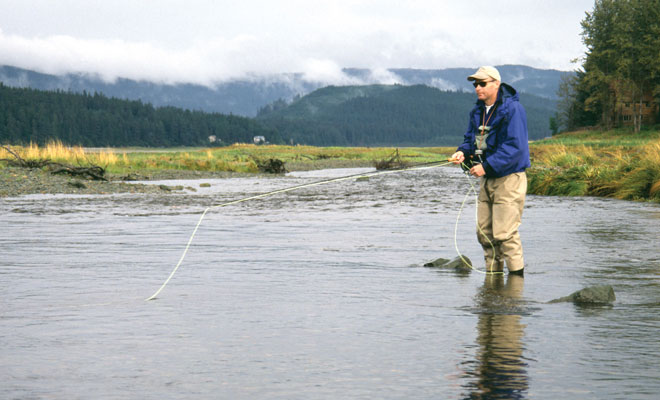
Hot Kings on Juneau’s Doorstop
By Terry W. Sheely
The black rod in the corner holder, the whippy one spooled with that garish fluorescent monofilament, shudders, bounces, slams down and I’m up and into a king.
Tip up, throbbing, tight down, hang on–red line is leaking off the reel by the yard. It’s a scramble. Spilled coffee slides across the deck; Rick nails the up-button on the downrigger and clears two other rods. Jim swings his rig into the boat and grabs the hooks. The chrome flasher spins past my head.
This fish isn’t big, maybe 20 pounds, but it has shoulders and it’s running hard. The monofilament hisses a wide smile through the water, a half-moon incision that rips past the North Douglas boat ramp where kayaks are lined up like colored caterpillars waiting for their cruise ship explorers. Beach casters are slinging spinners, spoons, and Buzz Bombs, and nearby a couple of dozen charter and private boats troll a little too close to my comfort zone.
Rick waves the net and the boats slide away. Our rods are cleared, downriggers cranked. It’s just the king and I pushing each other around on Juneau’s wet doorstep.
The chinook sounds, grinds against the hooks, and streaks away. The rod bucks. Red line dives into the water. Several powerful spurts, a couple of heart-skittering surface wallows, and one good boat run. Rick leans and swings and the fish is in the mesh—another downtown DIPAC king hits the deck.
In the near distance, behind a swag of low clouds, is the wrinkled blue skin of Mendenhall Glacier. Floatplanes buzz the bay at the edge of Gastineau Channel alongside jets trading in and out of Juneau airport. My salmon, dime bright and heavily spotted, is photographed, bled, and headed for the fish box when a flock of helicopters lifts off the mainland. They look like dragonflies in formation, dragonflies packed with cruise ship escapees clutching tickets good for one glacier experience.
This may not be wilderness, but it is Alaska and I’m betting that the salmon action on this cloud-sopped mid-June morning is as hot as anywhere in Southeast. I know it’s hotter than it was just a few years ago, back in the dark ages when this massive and wholly artificial king run didn’t exist.
The five of us are trolling through a monster salmon enhancement program, a hatchery project tailored specifically to developing a summer-long blue-ribbon salmon fishery at the doorstep of Alaska’s capital city.
And it’s working!
Credit goes to the Douglas Island Pink and Chum Corporation (DIPAC) enhancement program, a project built around imprint net pond releases of two-thirds of a million hatchery Chinook salmon smolts. Every adult survivor of that massive smolt plant has been set aside by ADF&G specifically for sport fishers. Commercial fishing is not allowed in the Juneau marine area.
This year, Juneau’s front step is being splattered by the most generous catch-and-eat saltwater Chinook action in Alaska, one of a only a few places where non-residents can legally take home four kings and six coho a day, everyday until the jet lifts off or the cruise ship leaves.
In a bit of irony, the created Chinook fishery is also a godsend for king-hungry locals. Juneau is topographically isolated on a 45-mile long sliver of flat land wedged between saltwater and a vertical wall of mountains. Chinook spawning areas are few. Most of the region’s creeks and streams hurtle down rock faces, cascading to saltwater in a frothy staircase offering poor Chinook spawning habitat. Even the larger exceptions—Mendenhall River, Fish Creek, Montana Creek are small flows that spawn pinks, silvers, steelhead, and Dolly Varden, but offer minimal spawning room for big river kings.
It took creation of the DIPAC king run to bring Alaska’s state fish to the anglers of Alaska’s Capital City.
When DIPAC kings surge into the protected bays, points, and creek mouths along the Juneau and Douglas Island waterfronts, they are well within reach of rented kickers, trailered boats, and hardware hurlers slinging spoons and spinners from the beach. The kings are also growing a fleet of charter boats that offer fully furnished day trips from marinas in Auke Bay and downtown Juneau.
Non-resident anglers in the Lower 48 are also discovering that Juneau is not only a place of politics and tourism but also of nasty king salmon. Lots of them. Traveling anglers are squeezing in fishing time on both ends of business meetings, on half-day escapes from cruise ships, and weekend fish trips that start in Washington and Oregon just a two hour hop between major airports.
The Juneau salmon frenzy centers on the mid-June to early-July return of thousands of adult hatchery Chinook—the survivors of nearly three-quarters of a million smolts imprinted in local rearing pens and sent to sea to grow. On both sides of the hatchery Chinook return is the more restricted May-June run of wild kings and the late summer-early fall surges of silvers, pinks, and chums, plus the wild Dolly Varden and steelhead runs. The total DIPAC salmon impact is more than 160 million fry into Gastineau Channel.
Our boat is definitely getting impacted.
With my fish chilling in the box, we’ve got four rods out again each with a different terminal rig, sifting the dark green water of Fritz Cove at 20, 30, 40, and 60 feet above a bottom that roller coasters from 80 to 120-feet down. We’re towing a school of flashers, split tail herring, and three different color-patterns of plastic squid.

The author, left, and Doug Harris compare kings taken just off the Douglas Island beach.
Glacial silt leaching from the massive Mendenhall and the 1,800 square miles of Juneau Ice Field sours the surface with milky murk. A foot down, though, and the seawater runs clear.
The electronic fish finder blinks nonstop and it should—the water is filled with salmon. We’re straining the quiet cove along the shore of Douglas Island just above the mouth of Fish Creek. This is about as close to fishing in a hatchery as it gets. An imprint pond is located a mile or so up Fish Creek where a couple of years ago the kings that we are now fishing for were part of a few hundred thousand small smolts released to the sea.
Weather seems to be breaking after yesterday’s blow.
Clouds still hang on the emerald mountains and cling in ribbons above the shore but the water is flat, the rain has quit, and the salmon are hitting.
Every smolt from DIPAC’s Fish Creek imprint pond that survives to adulthood will, in two, three, or four years, be back in Fritz Cove drawn to the imprint pond as surely as if it was a natal stream. A scary share of this year’s return should be finning under our boat about now.
A small mudslide in the back of the cove, somewhere in the conifer trees above the North Douglas Highway, is dropping streaks of chocolate into the current. The dark water swirls along a gentle rip line that tracks the shore. It’s a magnet for kings.
We’ve already hit a few fish here, and we’re back trolling the mud line, weaving along the chocolate track toward a bulge in the pea gravel shoreline. Doug Harris interrupts the king fest with a big chum, dime bright and perfect for the table.

Chris Casey of Juneau, fly fishing in Fish Creek on Douglas Island not far from the Chinook imprint pond.
Minutes later small, glistening herring explode on both sides of Rick’s 26-foot Reel Job . More baitfish boil in the wake, skittering across the surface mad with panic.
Before we clear the herring ball, three rods pound down, tips pointing into green water at twisting Chinook.Jim Goerg nails a 24-pounder, Judy Harris adds a 24-pound twin to Jim’s fish, and a couple of passes later Doug puts a 17-pound king in the box.
It’s been a tide bite, and though the tide has long turned, we stubbornly pound the water for an hour after we should have given it up, held in place by strikes that promise more big kings but turn into small, early coho and big, silvery chums.
With half a dozen nice kings and a scattering of bright chums in the box, we finally call it a day. Tomorrow we do it again. Tonight we eat. Three crab pots in a shallow cove produce five big Dungeness, succulent complements to Rick’s grilled steaks and Karen’s salad fresh from the herb garden.
The Biermans, Rick and Karen, are among a handful of small businessmen—charter operators, boat renters, bait shops, and lodge providers—who have sprung up to service the new Juneau sport fishery.
Their operation is, as Rick describes it, a “micro-lodge,” a two bedroom B&B really, called “A Whale’s Eye Lodge.” Unlike most Juneau accommodations, Rick and Karen’s place is nicely removed from sidewalks and urban bustle. It’s tucked into an overhang of Sitka spruce and old cedars on roadless Shelter Island, a 30-minute boat ride north of town. The view from the porch sweeps over the herb and wild flower garden, across the beach rocks, the pewter gray of Saginaw Channel to the snow streaked peaks of the Chilkat Mountains on Admiralty Island.
It’s a laid-back, down-home operation where fishermen talk fishing, scratch Kahala the border collie behind the ears, and Karen turns out belt stretchers on her grandmother’s century-old, wood-fired iron stove. The view is alive with wildlife: humpback whales are common, seals, sea lions, otters, eagles, sea birds, black-tailed deer, and sometimes a mink or two.
An exceptional halibut and lingcod hole is a few hundred yards straight offshore at the end of a black reef. It’s a short run to the halibut flats and September silvers that flood in Icy Strait. A licensed charter operator, Rick fishes guests from A Whale’s Eye and day trips from Auke Bay.
He’s a DIPAC disciple.
On a quiet evening, coffee mugs steaming in cupped hands, feet propped on the porch railing, we talk about the hatchery enhancement. He calls the DIPAC kings “peacemaker fish.” They don’t hurt anyone’s quota and it doesn’t take away from the gillnetters and trollers.
“It’s good [economically] for the town and it’s really good for the fishermen and the guides,” Bierman says. “If we didn’t have these fish we’d have several weeks [of no fishing] between the last of the native kings and the arrival of the late summer silvers and pinks.
“With DIPAC we can fish kings right through the season. First we get the wild kings in May and early June, then we have the DIPAC kings which last until the ocean silvers and pinks get here in July.”
The hatchery project has created an enthusiastic sport Chinook fishery for Juneau kicker boaters, provides shoreline Chinook fishing in Gastineau Channel and Auke Bay along the Juneau waterfront, and developed a hugely popular king fishery in Fish Creek on Douglas Island, which is connected to Juneau by a bridge across Gastineau Channel.
An eagle, young and mottled, sweeps in and drops onto the rocks below the porch where we cleaned the crab.
“DIPAC,” Rick explains, “has a contract with the Alaska Department of Fish and Game, Division of Sport Fish, to operate imprint pens at Fish Creek where 180,000 Chinook smolts are imprinted, in Auke Bay near the mouth of Auke Creek which holds 120,000 chinook smolts, at the Macaulay Salmon Hatchery (220,000 Chinook smolts), and at the mouth of Sheep Creek (100,000 smolts).”
The next morning, with several hours to kill until the slack tide bite in Juneau, we head for Icy Strait where Rick promises halibut.
On the run, we pass humpback whales. One breaches through the surface, rising straight up and crashing down. The impact explodes a wall of tropically-blue turquoise water. Another humpback is plowing along the surface, throwing a yacht-size bow wake, fluke pounding, mouth open, scooping in bait—probably a giant ball of herring. The behemoth churns across the surface for at least 150 yards before stalling out. I’ve seen a lot of whales, but I’ve never seen anything like this.
The Reel Job rounds a point into Icy Strait and rams into six-foot whitecaps and a gathering wind that’s blowing froth down the troughs. We slow and plow. Rick checks the radio for weather and comes up with bad news. The winds are going to howl, worse will get here before better. Anchoring up for halibut, if even possible, would be brutal and probably dangerous. We plow, hang on, and chew over alternatives. Salt spray is flying.
We head for Juneau.
The inside water is dead calm and the overcast is thinning, probably pushed apart by the howler outside. A few sun spears poke through the gray. Doug nails a small coho in Fritz Cove before the rest of the rods can be set out. It’s a good a omen. Judy adds a big chum that comes in like a log. The 8/0 hook has speared the fish squarely through the brain.
Jim lands a nasty 12-pound chum and I contribute a pair of walleyed pollack.
Fun, but we’re waiting for the king bite.
Two rods go off—it’s my turn in the rotation and I grab the closest. The other rod is doubled over and poking into the water, drag screeching line. Doug struggles to clear it.
Crossed lines, banged rods, clearing gear, sailing hooks, raising downriggers, stumbling and laughing. When it’s all over Rick is standing spraddle-legged over 27 and 23-pound kings and Doug and I are high-fiving and grinning.
My king nailed a plastic squid, colored pink, black, and purple with a glow belly. Rick calls the hoochie his Jimi Hendrix Purple Haze. I was trolling Hendrix’ Hazy Hoochie behind a rainbow flasher. Doug’s fish ate a white squid behind a white flasher. We were trolling the chocolate line at 30 and 60 feet.
Before we’re finished with the atta boys and hero photos, Judy’s rod slams down on a 15-pounder. It’s barely in the boat when Jim adds a 12-pound chum.
Eventually, we cross over to the marina in Auke Bay, make a fuel stop, stretch our legs, and stock up on junk food at the store. We’re fishing again less than 100 yards outside the marina. “Good spot,” Rick says. It doesn’t take long. Just off an anchored commercial boat Judy crosses the eyes of a 12-pound chum that fights so hard we’re sure it’s a king right up until it slides into the net.
A few kicker boats and a couple of charter outfits are working the marina waters trying to eke out another fish or two before calling it a day. They’ll probably get ’em. Another imprint net pen is nearby.
On our last day, the wind is ripping 20 knots in the low spots and skidding wave scud out on Lynn Canal. We find quiet water inside at Otter Point where we scratch out four chums and another hefty king on the tide-change.
The weather is making it tough, spreading out the bites, but the eagle attack fires up the excitement level. Jim is swinging another big chum toward Rick’s waiting net, just off the transom, when a bald eagle careens across our heads from behind and dives on the salmon in the net. It misses everything—the fish, hooks, net, us.
The weather change has shattered the salmon schools. We mark individual kings but they’re scattered top to bottom and definitely off the bite. Nothing like yesterday, nothing like the day before that.
Finally, Jim hits a hot king that runs hard, dives, surfaces, splatters, and simply comes unbuttoned.
By late afternoon, the weather is improving. High clouds in the north, blue sky blowing up from the south. At the back of the bay we scratch out a 22-pound king, add another bright chum, and head for the lodge. Judy and Doug go with Rick to pull crab pots.
There’s a fire, mosquito candles, a porch, glasses of good Merlot the color of evening, and a pair of humpback whales blowing nearby. Sea birds are silhouetted against pewter. In the distance the ice-packed teeth at the top of the Chilkat Mountains chew into the horizon. I’m watching salmon leap in the flickering candle fire. DIPAC salmon.
Hot New Kings on Juneau’s Wet Doorstep originally appeared in the May 2004 issue of Fish Alaska magazine.


